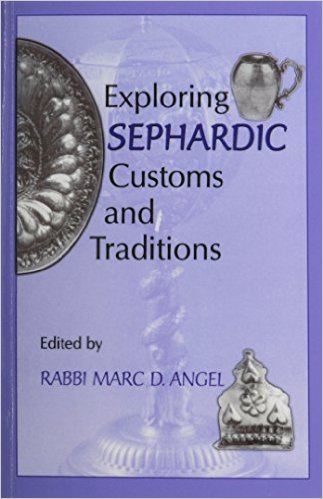
Book Review: Exploring Sephardic Customs and Traditions
Exploring Sephardic Customs and Traditions
Editor: Rabbi Marc D. Angel
Publisher: Ktav Publishing House, Inc.
Year: 2000
Pages: 69 plus addendum
Sephardic Customs and Traditions is a brief overview of various important customs that are prevalent in the Sephardic world. Traditionally, Sephardic Jews are defined as Jews who come from the Iberian Peninsula. When the Sephardim were expelled from Spain and Portugal many found their way to various European countries as well as Middle-Eastern countries and areas controlled by the Ottoman Empire. Many in the original European (known as the Western Sephardim) Jewish communities came to the Americas and established a Jewish presence.
After this short history, Rabbi Angel goes on to explain that in addition to halakhah, various traditions and practices arose in various communities. These minhagim (customs) varied from one community to another but many of the practices became know to – and adopted by – the various Sephardim. Today, Sephardim generally refers not only to the Jews from the Iberian Peninsula but also to the Jews of the Middle-East and Asia. One significant minhag in the Sephardic community is a reverence for the rabbi. It is customary to show great respect for the rabbi and in return for the rabbi to bless the community.
For many Sephardim the Zohar has become an important text within the community. The Zohar is studied by many within the community and is considered a very important text to assist the student in becoming closer to God. There is also an emphasis on celebration and joy with the Sephardic community. Joyous celebration is emphasized throughout the daily and religious lives of the Sephardim. Rabbi Angel goes on to describe how gracefulness and good manners are also emphasized amongst the Sephardim as is the importance of not flaunting one’s piety. The customs and differences between Ashkenazim and Sephardim during Pesach, Shavuot, and Sukkot are also explored.
Rabbi Avraham Benhamu presents the minhagim of Sephardim in relation to Shabbat. Shabbat preparations – such a personal grooming and lighting Shabbat candles – are explored from a Sephardic perspective. Rabbi Benhamu also explores the differing Sephardic minhagim of erev Shabbat, T’fillah, and Havdalah.
Rabbi Hayyim Angel goes on to explain the Sephardic minhagim of the High Holy Days. Rabbi Angel explores the variances of the music and clothing of the Sephardim as opposed to those of the Ashkenazim. Amongst the Sephardim there is much joy mixed with the trepidation of the coming judgment. It is customary for Sephardim to recite Selihot the entire forty days leading up to Yom Kippur. The Sephardim have for the most part rejected the custom of some Ashkenazim to perform self-flagellation during this period. In addition to the practice of eating apples and challah dipped in honey during Rosh Hashanah Sephardim minhagim also calls upon the eating of dates, gourds, and leeks and various other foods in elaborate rituals.
Rabbi Herbert Dobrinsky writes about the minhagim surrounding various lifecycle rituals. Many of these minhagim vary from one Sephardic community to another but they are all related to one another. There is a tradition for special Torah study and the study of the Zohar prior to the brit milah (circumcision) and upon the day of the brit milah it is customary for the paternal grandfather to be honored as the sandek (godfather) for the first son and the maternal grandfather for the second son – this switching of the honor of sandek is switched between the two grandfathers for each successive son. There are also various customs regarding the naming of children and the pidyon haben (Redemption of the Firstborn Son) within the Sephardic communities. Even thought Sephardim also consider a boy bar mitzvah at 13 years and one day it is also customary for young boys to have the honor of an aliyah (being called up to the Torah) and chanting the haftorah (reading from the Prophets). Sephardim engagements often bring elaborate rituals and much joyous celebrations. The wedding is generally carried out with a tallit (prayer shawl) placed over the heads of the bride and groom rather than a chupph (wedding canopy). In addition to shivah (seven-day mourning period) there are also various post-shiva customs to help the mourning person/family within the Sephardic community.
Overall, for such a short book, Exploring Sephardic Customs and Traditions is a well-written exploration of Sephardic minhagim. Anyone interested in exploring Sephardic customs would do well to begin the exploration into Sephardic customs by reading this book.
